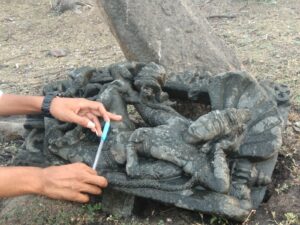Ranganayakula Gutta, Bauni Cheruvu – Signs of Satavahanas rule in Telangana
A precious historical treasure in the suburb of Venkatapur of Ellareddypet mandal of Rajanna Sircilla district. If we turn the pages of history, we will find many interesting aspects related to the period in Satavahana. For 450 years from 230 BC to 220 AD, the Satavahanas seem to have ruled over a vast territory in India. During this period, it seems that there was a lot of commercial development. Historical evidence shows that exports from here were made to many countries around the world. It seems that the Satavahana kings, who made the river catchment areas the centers, made many innovations in the development of the society of that time. It is known that historians have confirmed that Kotilinga in the Godavari coastal region of Telangana state was the capital during their rule.
In the course of continuing the study on the issue of where the landmarks related to the Satavahana period are located in the districts, the research has progressed with the information given by the villagers of Venkatapur of Ellareddypet mandal. Here the names of two villages which do not exist at present have been mentioned by the villagers. One is at Baupeta, the second is at Narsampally. The discovery continued in the first area. A monolith similar to the one found at Chityala Penta, a metal refining center on the outskirts of Venkatapur, was found in the fields here. Examining the pillar, along with the statue of Hanuman, some marks of the Satavahana period were vaguely seen. Villagers said that under the layers of earth in the surrounding green fields, there are traces of the erstwhile village of Baupeta. Right in front of the single pillar is an area known as Ranganayakula Gutta. The Satavahanas seem to have followed the Vaishnava tradition of treating all Dharmas as equal. Ranganayakula Gutta on its top a large mound and on its top the statue of Hanuman along with the statues of Ranganayaka and the Vaishnava Guru. The statue is engraved. In the lower part, another gundu, and above four pratimas are clearly visible. All these make clear the marks of the period of the Satavahanas. It seems that the village of Baupeta came into being after the complete cessation of trade from this region in the post-Satavahana era. To reveal the full history and leave the mystery, historical researchers have to reveal more things.
Special mention should be made about the pond built on the back side of the fort, which is thought to be the fort of Ranganayakas. This pond, which is still bubbling with water, is known as Bauni pond by the locals. The pond is also a reflection of Satavahana culture with the stone steps built to get down to the pond still had the traces of the history of that time. During that period, people are known to take dip in this pond and worship the Ranganayakas on the mound. The path from the pond to the top of the hill is also easy. The agricultural lands in Venkatapur are irrigated through the Cheruru Mattadi canal. These show the Satavahana Gurus lying around the Ranganayaka’s mound.
Alley Ramesh, Journalist





